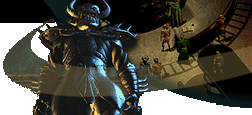Video Troubleshooting
This page describes how to fix various graphics problems with Baldur's Gate and Tales of the Sword Coast.
If you have a 2 MB video card, you will be able to see the game in 16-bit colour (65,000 colors) while those with 4 MB or more of video RAM can enjoy 24-bit or 32-bit colour (> 16 million colours). Not all cards support both 24-bit and 32-bit colour; use the choice that is available to you (not grayed out). It is wise to set your Baldur's Gate and Windows desktop colour depths the same, such as both in 32-bit. The screen resolution is 640 x 480 and not adjustable. The game can be run either in full-screen mode or in a window (Alt-Enter), although the latter may reduce performance.
A 3D card such as a Voodoo2 or TNT is unnecessary because Baldur's Gate is a 2D, not a 3D, game. Baldur's Gate does not use Direct3D, OpenGL, or Glide. However, sequels may use some 3D routines for rendering "special effects". The Direct3D setting found in the DXTOOL.EXE program can be turned off without affecting Baldur's Gate.
There is a known bug with the Voodoo3 chipset. DO NOT minimize Baldur's
Gate and then maximize it later if you have this chipset. The game
can experience a problem redrawing the screen when this is done and
will appear to crash, even though the game is just not drawing to the
screen. This bug will hopefully be fixed in future revisions of the
Voodoo 3 video drivers.
To avoid video problems, make sure your video drivers are the latest versions and DirectX compliant. Interplay has listed drivers known to work for each card on their Hardware Configuration page. If the drivers listed for your machine don't work, you could try the generic reference drivers for your video card such as drivers from S3 for some Compaq models or the nVidia reference drivers for some TNT cards. Also ensure that you have the latest version of DirectX. DirectX 6.0 was shipped on the Baldur's Gate CD1 and can be installed from there. Refer to Interplay's DirectX Troubleshooting Guide for additional assistance. At least DirectX 6.1 should be used with Tales of the Sword Coast.
If you are seeing numbers such as 1, 3, 7 being entered into text fields when you move the mouse and are using a Compaq computer, you should install a mouse driver for a Microsoft-compatible mouse like a Microsoft Standard PS/2 or serial mouse depending on your configuration.
Especially problematic are the Matrox Millenium I and the Permedia cards. Bioware included a software renderer that can accomplish some of the tasks that the video cards are failing to do. The nature of the graphical glitches with these cards and how to try to reduce them are discussed at the Interplay Support site. Turning on some of these options in Baldur's Gate may fix the video problems but will reduce performance. Furthermore, Peter Tiedemann has a website where he explains how he got Baldur's Gate to work with a Millenium I card.
Mouse trails result from an inconsistency in the way double buffering is being done on some cards. They are only seen with some video cards and are technically the fault of the video driver. If you are experiencing mouse trails, the following are some things you can try:
- Install the latest video and sound drivers for your hardware.
- Go into windowed mode and then back to full screen mode by pressing Alt-Enter twice.
- Changing color depth for both the desktop and the game to either 16-bit or 24/32-bit.
- Turn off full screen mode under Baldur's Gate Graphics Options, set your desktop to 640x480 resolution and play the game.
- Adjust Hardware Acceleration under My Computer Properties --> Performance --> Advanced Graphics. See if one of the four slider positions helps the problem (turning it off still caused mouse trails for some people).
- Run the DXTOOL.EXE program in your DirectX folder and turn off DirectDraw acceleration. Run and exit Baldur's Gate and then turn this back on.
- Turn off Direct3D in DXTOOL.EXE and card-specific control panels for 3D cards such as Voodoo2.
- Get a new video card.
RedGuru submitted the following fix for mouse trails with some TNT video cards:
Some people who are experiencing mouse trails on TNT cards and
have optimized them for other games, (i.e. Quake2, Unreal) turn on a
registry setting to allow them to disable a wait for VSYNC in their
display properties. To fix the mouse trails in BG, the following steps
are necessary.
1. Go into display Properties|Settings|Advanced|Riva TNT.
2. Click on Additional Properties.
3. Go to the Direct3D tab.
4. Click on Advanced.
5. Remove the checkmark on "Disable wait for VBLANK".
This fix should only affect users who have enabled a registry DWORD
"PowerUser" in
HKEY_LOCAL_MACHINE\Software\NVIDIA Corporation\RIVA TNT\NVTweak
This fix may also affect other combo 2D/3D card users who have disabled
the SYNC wait, but the format for changing it back will be different.
|

